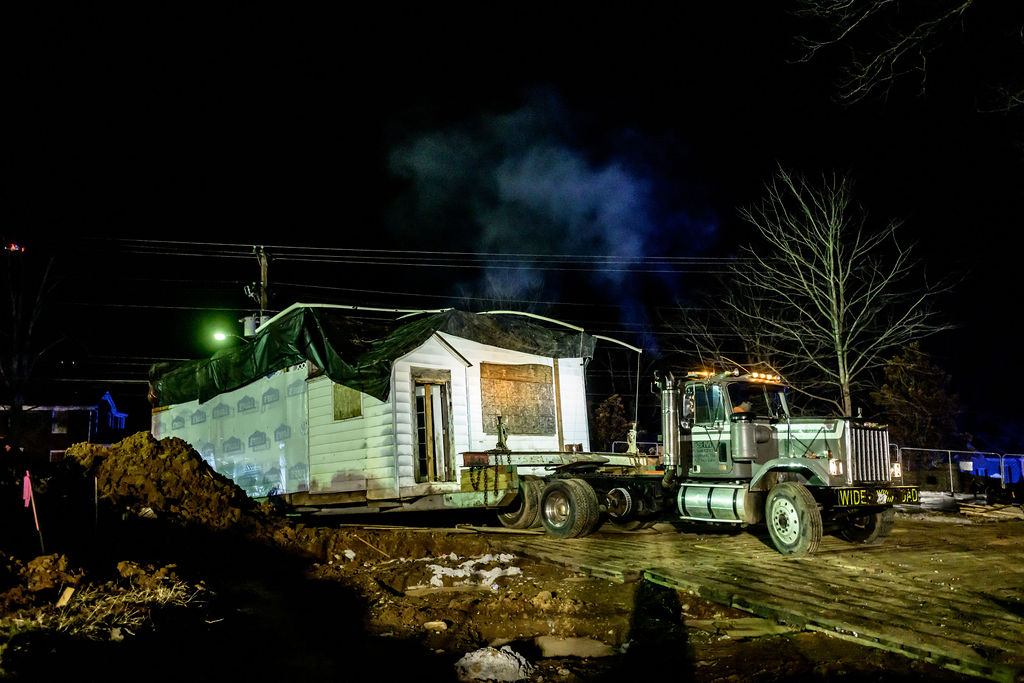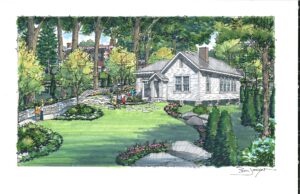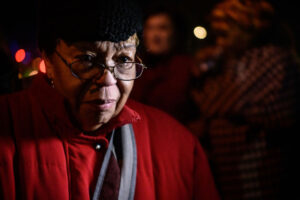
On a suburban street in Franklin, Tenn., in the early hours of a February morning, the Lee-Buckner School, a white clapboard schoolhouse, glides by on the back of a semi-truck — slowly, carefully, like the grand marshal of a parade. It’s in the last leg of a 13-mile journey from the tiny rural community of Duplex to its new home in Franklin. Police cars flash their blue lights, blocking off traffic at the end of the road. And watching it all unfold is a group of former students, plus researchers and fundraisers from the Heritage Foundation of Williamson County, who all worked together to make this night happen.
 Heritage Foundation of Williamson County
Heritage Foundation of Williamson County A group of Heritage Foundation of Williamson County staff and former students of the Lee-Buckner School watch as the Lee-Buckner building is moved to its new home in downtown Franklin.
Lee-Buckner was a Rosenwald School — one of about 5,000 rural schoolhouses for Black children funded by Jewish philanthropist Julius Rosenwald in the first half of the 20th century. The schools shut down after integration, and only about 500 are still standing today.
Relocating the Lee-Buckner to Franklin is the first step in a multi-year plan to restore the schoolhouse as it looked when it was built nearly a century ago, and to open it to the public as a historic site.
Georgia Harris, who attended elementary and middle school there during the 1940s and ’50s, said getting the school to its new location took years of planning and a moment of serendipity. Back in 2018, she told the Heritage Foundation about where she went to school, and they just happened to be looking for Rosenwald schools in the county to preserve.
“I never heard of a Rosenwald school. Nobody never told me that’s where I went … Next thing I know, the Heritage (Foundation) went out and bought it,” she said.
Preserving Rosenwald schools
When schools like Lee-Buckner were built, Julius Rosenwald’s foundation knew they would be segregated, but still expected buy-in from neighbors of all races.
“The fund would give a third, but then the fund also expected that there would be contributions from the community, Black and white. So a third from the Black community and a third from the white community. And that is how these schools were built,” said Rachel Finch, a historian with the Heritage Foundation.
Finch said that, after it closed down, Lee-Buckner was one of many Rosenwald schools that survived by being reused.
“It was a community center. It even became a local nightclub at one point,” she said. “And then it became a house. A family lived in it.”
It’s less common for Rosenwald schools to be preserved as historic sites. Finch says this is the only one she’s aware of in Middle Tennessee.
Just like building the school, preserving Lee-Buckner a century later has taken interracial collaboration, this time between Black alumni of the school and the mostly white Heritage Foundation. Alumna Georgia Harris says they faced pushback from some white community members in Franklin.
 Heritage Foundation of Williamson County
Heritage Foundation of Williamson County An artist’s rendering of the Lee-Buckner School once it is restored and opened as a historic site.
“They said it would be noisy; it would cause too much traffic,” she said. “A lot of people didn’t want it here because it’s a Black school. That’s what I say.”
Harris said she was surprised and delighted when Franklin officials finally gave the go-ahead to move the school. Heritage Foundation CEO Bari Beasley said that the school’s new location gives her hope that Franklin has changed.
“Way back in the day, this was really a redlined community where African Americans could not own or rent here,” Beasley said. “To move it here and to know that this schoolhouse that tells an important part of history during a time of segregation is now in this incredible downtown historic Franklin, two blocks off the square ― it’s very symbolic.”
‘We’ll be able to teach the next generation’
On that February morning, after some complicated parking maneuvers, the school is finally ready to be unloaded. The former students, including Georgia Harris, gather nearby to share memories of growing up and going to school in Duplex.
“Well, you know, the whole school is all kin. We were all cousins, because it was a small community,” Harris remembered. “There was no electricity at that time. We had a potbellied stove that the boys would come early and make the fire.”
The school was a single room with students ranging from kindergarten to eighth grade. Students did group work in each corner, and the teacher floated between them.
 Heritage Foundation of Williamson County
Heritage Foundation of Williamson County Georgia Harris attended the Lee-Buckner School in the 1940s and ’50s. She first told the Heritage Foundation of Williamson County about her school in 2018.
“The teacher, I thought, was really smart,” Harris said. “She played piano, so she taught us how to read music. She had classical music she played with us.”
Harris credits the lessons for her love of classical music today. Mary Adkinson remembered the music too.
“We learned traditional hymns (like) one of my favorite songs, ‘I Come to the Garden Alone,'” she said. “We still sing today in church, but that’s where we started.”
Adkinson’s parents, born in 1920 and 1924, attended the same school when they were growing up. They insisted that their children take education seriously.
“That was their one rule: You went to school, and you went to church,” said Adkinson’s sister, Diane Adkinson. “We used to have to walk to school in snow, up to our knees. We didn’t have a bus to go to school, so we had to walk about two miles … You wore what clothes you had.”
“We didn’t have shoes sometimes,” Mary Adkindon added. “Mama would get the shoes from the white people’s houses and cut the heels off.”
Many Lee-Buckner students went on to attend high school and college. Finch, the Heritage Foundation historian, talked with many graduates of the school who went on to have impressive careers.
“To be able to then become, you know, a police officer, an attorney, educators, medical technicians. It’s amazing the careers that so many of them have had, and they all really give the praise to being able to go to the Lee-Buckner Rosenwald school,” she said.
Diane and Mary’s younger sister, Maudy Adkinson Johnson, went on from Lee-Buckner to the newly-integrated Franklin High School in the 1960s. She says it was a jarring experience to go from a tight-knit community to one in which virulent racism was on display each day.
“When we got there, nobody was on our side. We were always wrong, no matter what. We were the one that was wrong. If there was a fight, if somebody called, we had to go to the office and (be) put out of school. And the other (white) person stayed in school. We were not ready for that.”
Lee-Buckner will feature the former students’ memories when it opens as a historic site. Maudy Adkinson Johnson hopes visitors will be inspired by their struggles and successes, their stories of graduating from a tiny rural school and making their way in a rapidly changing world.
“We hung in there, and we’ll be able to teach the next generation because we hung in there,” she said. “We stood. Yeah, we just kept standing. So we’ll be able to teach the next generation.”
Sometimes my job as a reporter can be truly magical, like watching a historic Rosenwald schoolhouse move from Duplex to Franklin, TN in the dead of night. pic.twitter.com/Lv08Sha0M7
— Char Daston (@behindthissky) February 23, 2024

